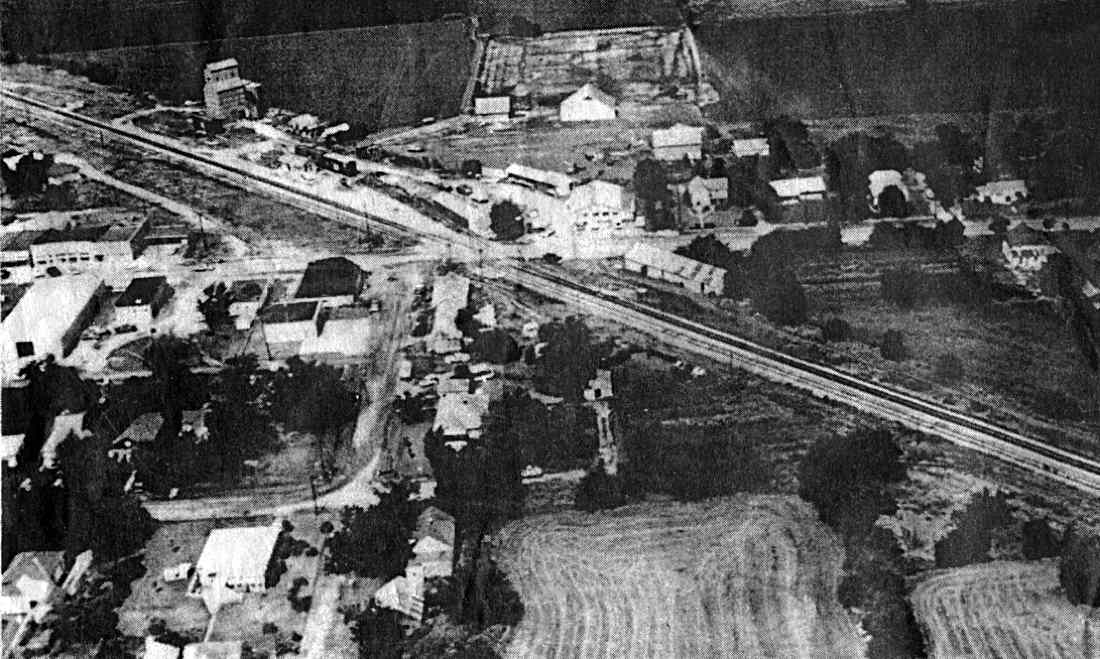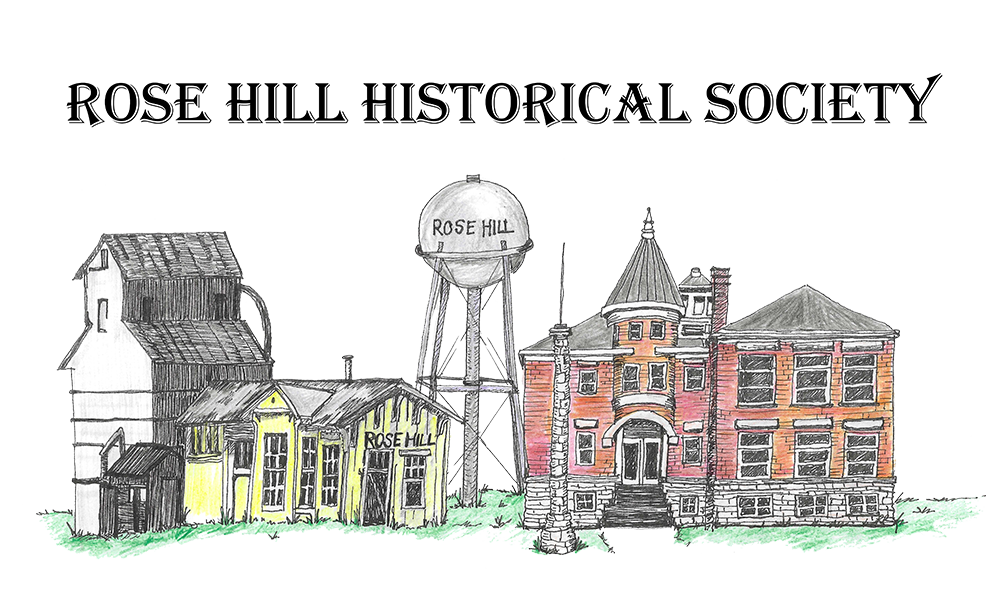
By Chris Wendt
Published in The Rose Hill Reporter, November 1, 2012
The following article documents views from some of the ‘old guard’ in 1987 as the town was celebrating its 100th anniversary. It was printed in the Rose Hill Reporter on Thursday, October 24, 1987 and written by editor Gail Simmons of Rose Hill.
As Rose Hill’s Centennial Celebration approaches, many of its residents will be talking over old times and discussing the many changes 100 years have brought to this community. Although the Centennial itself marks the town’s relocation from a mile east to its current site in 1887, other events have affected life in Rose Hill in important, if less dramatic ways.
At the turn of the century, Richland County historian L.D. Himebaugh described the “new” Rose Hill as a clean, tidy little village with buildings more artistically painted than any town in the county…with more and better sidewalks in proportion to the population than any wide awake town in the county. While Rose Hill is still clean and tidy, it can no longer be described as a village and there are certainly more people than sidewalks in town today. Rose Hill hasn’t changed its location since 1887, but that’s about the only thing that hasn’t changed.
According to Marshall Futhey, a life-long resident, who has an extensive collection of Rose Hill memorabilia, the town has had its share of fires, floods, blizzards and droughts, good time and bad throughout the past hundred years. In 1926, heavy snow stopped all road and rail traffic in the area and Rose Hill received its first and only air mail delivery of packages and letters.
In 1934, all the buildings south of the Rose Hill bank on Main St. burned to the ground. In 1936, drought and grasshoppers plagued the area once again. One year, floodwaters covered Rose Hill Rd. north of town. Grocery stores, ice cream parlors, hamburger stands and grain elevators have come and gone over the years.
Perhaps however, the biggest change in Rose Hill since 1887 has taken place in recent years. In the 1970’s Rose Hill’s long time residents, many of them descendants of those early pioneers who settled the area in the 1800’s, saw their town double and triple in size seemingly overnight. From a small town of 650 citizens a decade ago, Rose Hill’s population has grown to more than 2,100 today.
Esther Showalter, another life-long resident and descendant of the original settlers said, “Rose Hill was a pretty quiet place-a farming community-back when I was growing up. Everybody went to town on Saturday to do their shopping. We had a grocery store, the bank, an ice cream parlor and at time, a hamburger stand. We made up our own games back then too. We didn’t depend on television and radio for entertainment.”
What Showalter liked the most about that small town atmosphere was that everybody knew everybody else and they were all interested in the welfare of their neighbors and friends.
Gula Clinger, a native Rose Hill resident, remembers the time back in the ’30’s when she ran the cafe on Main Street where part of the Rose Hill Bank now stands today. “A hamburger cost a nickel back then and a good malt was a dime,” she reminisced. “On Saturday nights there were free shows on Main Street and everybody brought their chairs and milking stools and watched the shows.”
Ninety-five year-old Cecil Williamson was born and raised near Rose Hill and is the oldest living graduate of Rose Hill High School. Now a resident of Mulvane, Cecil remembers early-day Rose Hill as a little “hillbilly” town. She and her family came to town to sell eggs and cream and to attend Sunday school and church. Williamson’s aunt and uncle, John and Rose Silknitter, ran the post office when she was a girl and she remembers Phil and Mary Kinsey ran the little grocery store.
“From the old Staley House, north to the railroad tracks, was as far as the houses went,” said Williamson. “There were no houses south of the school house, it was a little tiny town.”
Rose Hill isn’t as tiny as it used to be and that has its good points and its bad points. Berlin Cox, who was Rose Hill’s mayor from 1961 to 1969, used to know everyone in town. Cox recalls that when he was mayor, there weren’t as many problems facing town as there are today. “There wasn’t as much money so there wasn’t as much to worry about,” he chucked. Cox admits things are better now, in spite of the problems. “You have to keep up with the time,” he said, citing the bigger and better school system as one advantage of the growth of the community.
Other advantages residents point to are the new water and sewer systems. “I remember when there was no water system in Rose Hill,” said Lucille Cox. “Today’s is quite an improvement!”
According to Mayor Steve Whetstine, the improvements have benefitted the entire community. After years of complaints from residents about the area’s water, Whetstine says Rose Hill now has an adequate supply of Wichita water and the old wells are no longer in use. The wastewater treatment facility built in 1983 has the capacity to serve 4,500 people with room to expand as the city grows, noted Whetstine.
And Rose Hill continues to grow. In the 1930’s Rose Hill boasted a population of maybe 150. By the time the city was incorporated in 1955, the tally was 308. Today it is almost seven times that size and a population of more than 3,300 is projected for 1995. Rose Hill growth has not occurred without some “growing pains,” however. “The biggest problem is street repair,” said whetstine. “Growth creates demand and there’s never enough money.”
Another problem mentioned by numerous Rose Hill citizens is the lack of businesses in the community, especially grocery stores. Since the closing of Rose Hill’s only grocery store earlier this year, residents must travel to Derby, Andover or Wichita to shop.
“We used to have two grocery stores here,” said Futhey. “Now we can’t even support one.” That frustration was echoed by Cheri Porter. “It seems like we always have to go somewhere else to get what we need,” she said. But Whetstine is optimistic about the future of business in Rose Hill.
“The Flemming Company still has a lease on the store building,” he explained. “They’re going to find an operator for the store, and I think we’ll have it open again. Maybe not in the next 30 days, but possibly in the next six months.” The mayor said the biggest problem in attracting new business to Rose Hill is the lack of existing buildings. “That makes their initial costs pretty high,” he noted.
Although the business community is not growing as fast as the general population, there are approximately 25 businesses or professions in town today, with a pizza parlor being the latest addition.
With the arrival of the B-1 bombers at the nearby McConnell Air Force Base, Whetstine looks for more growth in the area. “Things slowed down for two or three years, but it looks like it’s starting to pick up,” he added. “We’ve had more building applications in the past six months than we had for the past two years.”
Rose Hill is no longer just a sleepy little farming community where the people come to town on Saturday to sell eggs and cream and watch the free shows. Today it is a fast-growing city which has still managed to retain its attractive small town character through the years.
Although Rose Hill may experience a few more growing pains as it enters its second century, residents both old and new can be proud of a town which has survived the many changes of the past 100 years.

